TAC Fest 2010 Pages
 Soreng Theater [pic= photo566web.jpg]
Soreng Theater [pic= photo566web.jpg]
Daily Screening Schedule
Doors open one hour before the program. Seating begins one-half hour before the program.
| Tuesday, 18 May 2010 | |
| 6:30pm | Opening Ceremony |
| 6:50-7:21 | Secrets of the Nile Valley-Episode 1- Ancient Nubia (Poland) |
| 7:21-7:40 | Danzak (Peru) |
| 7:40-7:47 | Break |
| 7:47-8:45 | The Future of Mud:A Tale of Houses and Lives in Djenne (US,Mali) |
| 8:45-8:52 | Break |
| 8:52-9:44 | Herculaneum: Diaries of Darkness and Light (Italy) |
| Wednesday, 19 May 2010 | |
| 6:20 pm | Introductions |
| 6:30-6:36 | Mochica’s Sacrifice (Belgium) |
| 6:36-7:02 | The Phnom Kulen Archaeological Program (France) |
| 7:02-7:09 | Break |
| 7:09-8:39 | |
| 8:39-8:46 | Break |
| 8:46-9:38 | Seuthes the Immortal: Secrets of a Thracian King (France) |
| Thursday, 20 May 2010 | |
| 6:20 pm | Introductions |
| 6:30-7:23 | Death of the Megabeasts (Australia) |
| 7:23-7:30 | Break |
| 7:30-9:50 | Standing With Stones (UK) (with intermission break) |
|
|
|
| Friday, 21 May 2010 | |
| 6:20pm | Introductions |
| 6:30-7:17 | Chumpi’s Adventure (Peru) |
| 7:17-7:24 | Break |
| 7:24-8:04 | Life in Limbo (USA) |
| 8:04-8:11 | Break |
| 8:11-8:40 | Secrets of the Nile Valley-Episode 2-Upper Egypt (Poland) |
| 8:40-8:47 | Break |
| 8:47-9:47 | Keynote Address by Dr. Jon Erlandson |
|
|
|
| Saturday, 22 May 2010 | |
|
|
Session 1
|
| 10:50 am | Introductions |
| 11:00-11:57 | Lost Nation: The Ioway (USA) |
| 11:57-12:04 | Break |
| 12:04-12:26 | The Oasis of Glass (Egypt) |
| 12:26-1:18 | Stone Age Artists: The Magdalenian Masters (France) |
| 1:18-1:25 | Break |
| 1:25-1:54 | |
| 1:54-2:54 | Lunch Break |
|
Session 2
|
|
| 2:54-3:57 | Paddle Ship “Patris” Lost in 1868… (Greece) |
| 3:57-4:04 | Break |
| 4:04-5:38 | Death or Canada (Canada, Ireland) |
Video Bar
10 AM-5 PM, Wednesday through Friday, May 19-21, 2010
Bascom Room
Eugene Public Library
10th and Olive
Eugene, Oregon, USA
Producers and Distributors from 32 countries submitted 100 films to the juried competition at this year's Festival, but time would allow us to show only 19 of them on the big screen in the Soreng Theater. However, we want you to be able to see any of the entered films, so we've made most of them (all we could!) available for viewing at individual viewing stations in the Bascom Room of the Eugene Public Library. This is a free Video Bar, so be our guest---come and enjoy some great films!
Ages: All ages
Daily Schedule:
Wednesday through Friday, 19-21 May 2010, 10 AM-5 PM
Location:
Eugene Public Library, Bascom Room, 10th & Olive, Eugene, Oregon, USA
Fee: Library events are free and open to the public. Donations are accepted to support the Festival.
Lecture by Nancy Arthur Hoskins:
COPTIC EGYPTIAN TEXTILES
and
THE ARCHAEOLOGIST OF ANTINOÉ, ALBERT GAYET
Thursday, May 20, 2010
2 - 3:30 pm
Singer Room (2nd Floor)
Eugene Public Library
100 W. 10th Ave.
Frescoes, paintings, mosaics, and sculptures from all over the Roman Empire depict distinctive textiles decorated with tapestry such as those found in Coptic Egyptian burial sites (3rd -7th Century A.D.). The colorful ornaments illustrate birds, fish, fruit, flowers, figures, portraits, geometric motifs, religious symbols, and narrative scenes both classical and Christian. The tapestries and other textiles reveal the rich cultural construct of the time and place in which they were created. The lecture will focus on Hoskins’ book about the Archaeologist of Antinoé (an important Roman Period city in Egypt), Albert Gayet, and his connection with the unique collection of tapestry fragments at the Henry Art Gallery at the University of Washington. She will present still images from her museum research in over fifty museums and a display of her own personal collection of one thousand year old Coptic fragments.
About Nancy Arthur Hoskins
Researcher and Author on Egyptian Textiles

Nancy Arthur Hoskins, a former college weaving instructor, is the author of The Coptic Tapestry Albums and the Archaeologist of Antinoé, Albert Gayet; Universal Stitches for Weaving, Embroidery, and Other Fiber Arts; Weft-Faced Pattern Weaves: Tabby to Taqueté; and numerous articles. She has contributed chapters about Egyptian textiles to four other books. Her background includes a Master’s Degree in Fine Arts (Weaving), Art Education and Art History from the University of Oregon. Nancy has researched Coptic collections in over fifty museums and has presented lectures and workshops for national and international guilds and conferences. Hoskins’ art fabrics have been in solo, group, and invitational exhibits. In 2009 she led The Textiles of Egypt Tour in Egypt for Active Travel.
Day Trek to Cascadia Cave and Camas Prairie
Friday, 21 May, 9:30 a.m. - 5 p.m.
Ages: 12 and up, in good physical condition
Guide: Tony Farque, Archaeologist, Sweet Home Ranger District, Willamette NF
A special TAC Festival guided tour to one of the most visually impressive archaeological sites in western Oregon and also to an ancient root harvesting area that is under restoration. This tour is hosted by our partner, the Willamette National Forest.
| Program summary: |
Join us on a hike to one of the most visually impressive archaeological sites in western Oregon and also to an ancient root harvesting area that is under restoration. Used by people for 8000 or more years, Cascadia Cave is located along significant indigenous travel routes and provided important cultural functions to more than one tribal group. Here the largest group of rock art panels in western Oregon remains in excellent condition. Come view the site, hear excavation conclusions, discuss current rock art interpretations, and help plan site restoration, protection, and interpretation. As a bonus for this year's tour, we include a visit to nearby Camas Prairie, where archaeological evidence shows that people have been harvesting camas bulbs for at least 6000 years. In cooperation with the Grande Ronde and Siletz tribes as well as the BLM and Lane Community College, the Forest Service has been restoring the prairie through biannual burning and sowing, annual seed collection, and bulb harvesting. The camas lily is a beautiful blue flower that can turn a meadow into a gorgeous azure carpet in the springtime, but for Native American people in western Oregon its edible bulb has been a staple food for many thousands of years. This restoration project has been featured as a model for federal agency cooperation with Native American governments at conferences in Montreal, London and New Orleans. The camas may be in full bloom at the time of the tour. For early registrants, the Forest Service will provide a van for transportation from Eugene. Once the van is full, others will travel by car pooling.
Ages: 12 and up, in good physical condition
Guide: Tony Farque, Archaeologist, Sweet Home Ranger District, Willamette National Forest
Registration: Please contact Archaeological Legacy Institute
(filmfest@archaeologychannel>.org or or 541-345-5538 or 541-515-5976) to register. Please register as early as possible. TAC Festival tickets will be required of all participants.
Fee: No registration fee is required. However, we would appreciate a $20 or more donation to support the program.
Location: Meet at the Seventh Ave. turnout alongside the Hult Center, Eugene, Oregon, for 9:30 departure
Trip Information: : Last year's Cascadia Cave trek met with such an enthusiastic response that we decided to do it again! Bring a lunch to eat in the cave. Transportation will be through car-pooling and the drive is two hours each way. Be prepared for a two mile round trip hike through the woods along a flat river terrace. Also bring rain gear and boots and a change of warm clothes. We will cross one stream and follow a muddy path less traveled. We park at Cascadia State Park and use the rest rooms to change clothes if necessary. The tour then will drive to Camas Prairie, where you should expect only a very short walk.
We plan to return to the Hult Center by 5 p.m.
Conference on Cultural Heritage Film
Eugene Public Library, Tykeson Room
Eugene, Oregon, USA
18-21 May 2010
|
|
|
|
|
SCHEDULE
Wednesday, May 19, 2010 1:00 pm Festival film screenings (films entered but not to be screened at the Hult Umiaq Skin Boat (31 min.) 3:30 "How to Read a Film" (A workshop presented by Claudia Hemphill Pine, Lecturer in Environmental Science, University of Idaho) 5:00 End
1:00 pm Festival film screenings: Tigarnakert: An Armenian Odyssey (17 min.) 3:00 "ALI's Cultural Heritage Film Distribution Program" (Presented by Dr. Richard Pettigrew, Executive Director, Archaeological Legacy Institute) 3:30 "The Envelope, Please!" (A round table discussion moderated by Claudia Hemphill Pine, Lecturer in Environmental Science, University of Idaho, with TAC Festival jurors and ALI film curators) 5:00 End
1:00 Festival film screenings: In the Shadow of Liberty: The Search for James Oronoco Dexter (54 min.) 2:00 Student film dramas from the University of Washington (Presented by Amy Jordan, Ph.D. Candidate, Anthropology, University of Washington) 2:30 "The Making of Paddle Ship Patris" (Presented by Director Vasilis Mentogianis and Director of Photography Nikos Konitsiotis, both from Athens, Greece) 3:00 "Understanding Culture through Film: A Round Table Discussion with Professor Philip Young" 5:00 End
"How to Read a Film" (A workshop presented by Claudia Hemphill Pine, Lecturer in Environmental Science, University of Idaho) Movies have been called the most complex of all art forms, combining the stories told in novels with more visual images than an art museum, a musical tour, and more. Cultural heritage films add lessons in science, reflections on history, and travel across global time and space, to make a kaleidoscope mix of images, information, and entertainment. What do we call all the pieces? How do we talk about film? In this workshop session, film and anthropology teacher Claudia Hemphill Pine begins by reviewing the elements of film, using examples from the film festival to illustrate. Equipped with this understanding of cinema's key terms and techniques, we then look at how the Festival's films convey their meaning. Our discussion will focus on how the films we are viewing this week use camera work, setting, script, lighting, sound, special effects, and more to create the meanings we see.
Film distribution is a hard nut to crack, but Archaeological Legacy Institute is evolving a distribution approach for cultural heritage film that takes advantage of diverse new online distribution outlets combined with a large network of film producers. Development of The Archaeology Channel (ALI's popular streaming media Web site) and The Archaeology Channel International Film and Video Festival has moved ALI toward distribution as a natural component of its mission and business strategy. Rick Pettigrew, ALI's Executive Director, will explain ALI's distribution plans and lead a discussion about how to make it work.
Film awards are traditionally made by juries. Who's on a jury? What do they look for? Why do they sometimes disagree? To learn all the answers, join a distinguished panel of TAC Festival film reviewers and jurors for a roundtable discussion of the many things considered in selecting our "best of the best." With film clips from this and previous years, discover the many features in each film that are factored into the final evaluation, such as:
These two films were produced by students in the 2009 Archaeology 101 Title: "Horror in Hagget Hall" Title: "A Career in Ruins"
The film Director (Vasilis Mentogianis) and Director of Photography (Nikos Konitsiotis) for Paddle Ship "Patris" Lost in 1968 . . . have come all the way from their native country of Greece to represent their film, which will be screened for the TAC Festival 2010 competition at the Hult Center on Saturday afternoon (May 22). Come to welcome them to Eugene and hear them describe how they made this movie. Then ask a few questions!
The first documentary film ever made was the famous - and sometimes infamous - Nanook of the North. From its very beginning, film has been used to understand and record the world's many fascinating cultures, and this use has raised nearly every question that must be asked about the study of both culture and film. Join us in welcoming longtime teacher and researcher Phil Young to our annual conversation of experts from filmmaking, anthropology, and education. Bring your own questions and observations to contribute to our ongoing discussion of art, ethics, education, science, society and anthropology in film.
Umiaq Skin Boat (31 min.) Umiaq Skin Boat is a beautiful and poetic 30-minute film about a group of Inuit elders in Inukjuak, Quebec, who decide one summer to build the first traditional seal skin boat their community has seen for over 50 years. Over the course of working together on the boat, the elders recount astonishing stories of survival while navigating volatile and unforgiving Arctic water. Heirs of Schliemann - Escape from Babylon (43 min.) A king of mighty Babylon allegedly left his lush residence in his capitol city and vanished into the desert for a whole ten years. Indeed, traces of this mysterious regent can be found in the small town of Tayma in what is today's Saudi Arabia. But what could have drawn a Babylonian ruler to this unimpressive oasis in the middle of nowhere, and who was he? Visit With Respect (9 min.) Visit with Respect demonstrates modern Pueblo people's connections with their ancestral homelands and the ancient landscapes of the American Southwest. Filmed in Canyons of the Ancients National Monument and at the Pueblo of Acoma, the film includes interviews with a Hopi man and his 6 year old son, a Santa Clara elder and her 22 year old niece, and an Acoma tribal leader. Hanging Flume (60 min.) In this still wild land, it stands out, clearly fashioned by human hands. Amidst the tall tales is a seldom told story of the Wild West. Braced against weather and tumbling rocks, slowly decaying timbers still cling tenaciously, as if hanging on to the past. Travel back to 1891, when the flume carried water ten miles and powered hydraulic cannons for the Montrose Placer Mining Company. Tigarnakert: An Armenian Odyssey (17 min.) Tigranakert: An Armenian Odyssey chronicles the discovery of an ancient Armenian city built by Tigran the Great in the First Century B.C. It was founded as the new capital of the Armenian Empire with the intention of securing a central position inside the borders of the growing empire. Under the rule of Tigran the Great, the Armenian Empire became the strongest state east of the Roman Empire. Gold Diggers and Temple Rescuers - A Cambodian Expedition (26 min.) Hardly any other country can boast of such a high concentration of temples, sculptures and archaeological sites as Cambodia. But many of these fascinating world heritage artifacts are under environmental threat or are in danger of being looted. Archaeologists and conservation experts are trying to salvage whatever they can to safeguard remote cult sites, burial grounds and rock reliefs. What Is Archaeology? (6 min.) With scenes from 2006 fieldwork in central Washington State, Faith Haney offers her personal interpretation of archaeology. Haney created this video as a Career Day exhibit for Middle School students and in the process captured key insights about the values and purposes of archaeology. Lifeprints (Traces de Vies) (54 min.) Where did Austronesians come from? How did they live? There is still no concrete answer because those who were at the origin of the populating of the Pacific did not leave material tracks. However, in the Philippines they have direct descendants, the Taut' Batu. This film explores the most protected island in the Philippines and new hypotheses on the enigmatic peopling of the Pacific. In the Shadow of Liberty: The Search for James Oronoco Dexter (54 min.) Follow archaeologists and historians as they begin a search for an 18th Century man, James Oronoko Dexter, who once was enslaved. He was an African American who with others helped found some of the country's first African American social institutions. Thousands of artifacts are unearthed while one feature seems to contain household artifacts that date to the time Oronoko Dexter lived at the site. |
||
Awards Reception
Saturday, 22 May, 6:30-9:00 pm
Downtown Initiative for the Visual Arts (DIVA)
110 W. Broadway
Eugene, Oregon, USA
|
Open to all ages
|
$5 general admission. Tickets at the door. No pre-registration required.
After all the films have been screened and you have cast your ballots, join us for some finger food and beverages as we compile the results of the competition. When the jury and audience voting tallies are complete, sit back and watch the announcement of the winners. We will show clips of the top films and open sealed envelopes to reveal the final outcome. The room holds only about 50 people, so don't be late!
About Jon Erlandson
Director, University of Oregon Museum of Natural and Cultural History

Dr. Jon Erlandson is an archaeologist, professor of anthropology, and Knight Professor of Arts and Sciences at the University of Oregon (UO), where he also serves as the Director of the Museum of Natural and Cultural History and co-editor of the Journal of Island and Coastal Archaeology. He earned his Ph.D. from the University of California, Santa Barbara, (UCSB) in 1988, and taught at UCSB and the University of Alaska-Fairbanks before joining the faculty at the UO in 1990. Erlandson's research revolves around the origins and development of maritime societies, human migrations, the peopling of the Americas, historical ecology, and the history of human impacts on marine fisheries and ecosystems. His primary focus of field research is on the California Channel Islands and the California Coast, although he has also worked along the Oregon Coast, in Alaska, and on Viking Age sites in Iceland. Erlandson has published 16 books and over 200 scholarly articles on these and other topics. His most recent books include Human Impacts on Ancient Marine Ecosystems: A Global Perspective (University of California Press, 2008, with T. C. Rick) and A Canyon Through Time: Archaeology, History, and Ecology of Tecolote Canyon, Santa Barbara County, California (University of Utah Press, 2008).
Award Selections
| Best Film (by Jury) |
|
Paddle Ship “Patris” Lost in 1868... (Produced by Hellenic Broadcasting Corporation, TEXNIS, the Museum of Industrial Heritage of Syros, and Underwater Filming and Research; Greece) Honorable Mention (in order): Standing with Stones (Produced by Michael Bott, Illuminated World Ltd; distributed by The Disinformation Company Ltd; UK) The Future of Mud: A Tale of Houses and Lives in Djenne (Produced by Susan Vogel, Prince Street Pictures; distributed by Icarus Films; USA, Mali) Stone Age Artists: The Magdalenian Masters (Produced by Thierry Berrod, Mona Lisa Production; distributed by Mona Lisa Production; France) Life in Limbo (Produced by Sakae Ishikawa, 212 Film World LLC; USA) Lost Nation: The Ioway (Produced by Kelly and Tammy Rundle, Fourth Wall Films; distributed by Fourth Wall Films; USA) |
|
|
| Special Mention (by Jury) |
|
The Future of Mud: A Tale of Houses and Lives in Djenne (Produced by Susan Vogel, Prince Street Pictures; distributed by Icarus Films; USA, Mali); for the best film on preservation of Cultural Heritage. The Phnom Kulen Archaeological Program (Produced and distributed by ZED; France); for exemplary demonstration of professional archaeological responsibilities. Chumpi’s Adventure (Produced and distributed by Teleandes Productions; Peru); for the best ethnographic film. |
|
|
| Best Narration (by Jury) |
|
Standing with Stones (Produced by Michael Bott, Illuminated World Ltd; distributed by The Disinformation Company Ltd; UK) Honorable Mention (in order): Death of the Megabeasts (Produced by Prospero Productions; distributed by National Geographic Television International; Australia) Paddle Ship “Patris” Lost in 1868... (Produced by Hellenic Broadcasting Corporation, TEXNIS, the Museum of Industrial Heritage of Syros, and Underwater Filming and Research; Greece) Stone Age Artists: The Magdalenian Masters (Produced by Thierry Berrod, Mona Lisa Production; distributed by Mona Lisa Production; France) The Future of Mud: A Tale of Houses and Lives in Djenne (Produced by Susan Vogel, Prince Street Pictures; distributed by Icarus Films; USA, Mali) |
|
|
| Best Animation (by Jury) |
|
Mochica’s Sacrifice (Produced by Royal Museum for Art and History Brussels; distributed by ASEHS; Belgium) Honorable Mention (in order): Paddle Ship “Patris” Lost in 1868... (Produced by Hellenic Broadcasting Corporation, TEXNIS, the Museum of Industrial Heritage of Syros, and Underwater Filming and Research; Greece) Stone Age Artists: The Magdalenian Masters (Produced by Thierry Berrod, Mona Lisa Production; distributed by Mona Lisa Production; France) Death of the Megabeasts (Produced by Prospero Productions; distributed by National Geographic Television International; Australia) Standing with Stones (Produced by Michael Bott, Illuminated World Ltd; distributed by The Disinformation Company Ltd; UK) |
|
|
| Best Special Effects (by Jury) |
|
Death of the Megabeasts (Produced by Prospero Productions; distributed by National Geographic Television International; Australia) Honorable Mention (in order): Mochica’s Sacrifice (Produced by Royal Museum for Art and History Brussels; distributed by ASEHS; Belgium) Stone Age Artists: The Magdalenian Masters (Produced by Thierry Berrod, Mona Lisa Production; distributed by Mona Lisa Production; France) Paddle Ship “Patris” Lost in 1868... (Produced by Hellenic Broadcasting Corporation, TEXNIS, the Museum of Industrial Heritage of Syros, and Underwater Filming and Research; Greece) Death or Canada (Produced by Craig Thompson, Ballinran Productions; distributed by Ballinran Productions; Canada, Ireland) |
|
|
| Best Script (by Jury) |
|
Stone Age Artists: The Magdalenian Masters (Produced by Thierry Berrod, Mona Lisa Production; distributed by Mona Lisa Production; France) Honorable Mention (in order): Standing with Stones (Produced by Michael Bott, Illuminated World Ltd; distributed by The Disinformation Company Ltd; UK) Paddle Ship “Patris” Lost in 1868... (Produced by Hellenic Broadcasting Corporation, TEXNIS, the Museum of Industrial Heritage of Syros, and Underwater Filming and Research; Greece) Chumpi’s Adventure (Produced and distributed by Teleandes Productions; Peru) The Future of Mud: A Tale of Houses and Lives in Djenne (Produced by Susan Vogel, Prince Street Pictures; distributed by Icarus Films; USA, Mali) |
|
|
| Best Cinematography (by Jury) |
|
Paddle Ship “Patris” Lost in 1868... (Produced by Hellenic Broadcasting Corporation, TEXNIS, the Museum of Industrial Heritage of Syros, and Underwater Filming and Research; Greece) Honorable Mention (in order): Stone Age Artists: The Magdalenian Masters (Produced by Thierry Berrod, Mona Lisa Production; distributed by Mona Lisa Production; France) Life in Limbo (Produced by Sakae Ishikawa, 212 Film World LLC; USA) Chumpi’s Adventure (Produced and distributed by Teleandes Productions; Peru) Secrets of the Nile Valley, Episode 2: Upper Egypt (Produced by Arkadia Film; distributed by TVP S.A.; Poland) |
|
|
| Best Music (by Jury) |
|
The Future of Mud: A Tale of Houses and Lives in Djenne (Produced by Susan Vogel, Prince Street Pictures; distributed by Icarus Films; USA, Mali) Honorable Mention (in order): Paddle Ship “Patris” Lost in 1868... (Produced by Hellenic Broadcasting Corporation, TEXNIS, the Museum of Industrial Heritage of Syros, and Underwater Filming and Research; Greece) Danzak (Produced and distributed by Gabriela Yepes; Peru) Standing with Stones (Produced by Michael Bott, Illuminated World Ltd; distributed by The Disinformation Company Ltd; UK) Life in Limbo (Produced by Sakae Ishikawa, 212 Film World LLC; USA) |
|
.
|
| Most Inspirational (by Jury) |
|
Standing with Stones (Produced by Michael Bott, Illuminated World Ltd; distributed by The Disinformation Company Ltd; UK) Honorable Mention (in order): Paddle Ship “Patris” Lost in 1868... (Produced by Hellenic Broadcasting Corporation, TEXNIS, the Museum of Industrial Heritage of Syros, and Underwater Filming and Research; Greece) Chumpi’s Adventure (Produced and distributed by Teleandes Productions; Peru) The Future of Mud: A Tale of Houses and Lives in Djenne (Produced by Susan Vogel, Prince Street Pictures; distributed by Icarus Films; USA, Mali) Stone Age Artists: The Magdalenian Masters (Produced by Thierry Berrod, Mona Lisa Production; distributed by Mona Lisa Production; France) |
|
|
| Audience Favorite Competition (by Festival audience) |
|
The Future of Mud: A Tale of Houses and Lives in Djenne (Produced by Susan Vogel, Prince Street Pictures; distributed by Icarus Films; USA, Mali) Honorable Mention (in order): Standing with Stones (Produced by Michael Bott, Illuminated World Ltd; distributed by The Disinformation Company Ltd; UK) When the Egyptians Sailed on the Red Sea (Produced by Sombrero and Co.; distributed by ARTE France; France) Death or Canada (Produced by Craig Thompson, Ballinran Productions; distributed by Ballinran Productions; Canada, Ireland) Life in Limbo (Produced by Sakae Ishikawa, 212 Film World LLC; USA) Stone Age Artists: The Magdalenian Masters (Produced by Thierry Berrod, Mona Lisa Production; distributed by Mona Lisa Production; France) |
 |
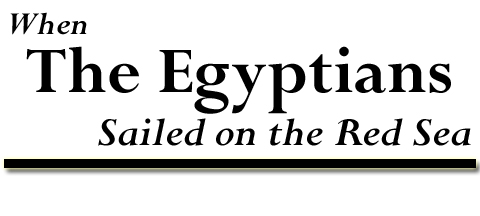 |
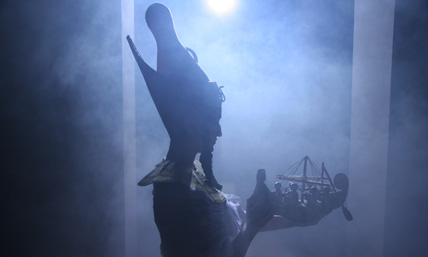
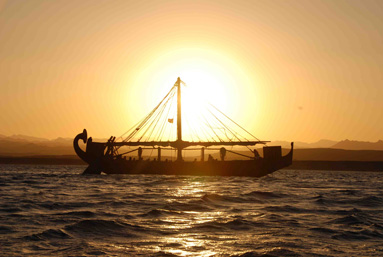
Cheryl Ward, American archaeologist and world specialist in ancient navigation, is coordinating the design and construction of the replica of an Egyptian ship from the time of the New Kingdom. Details for building the ship come from a bas-relief from the temple of Deir el-Bahri in Luxor. This inscriptions recounts that a fleet of five ships, supplied by Queen Hatshepsut in the year 1500 BC, succeeded in finding the marvelous and far-off land of Punt, from whence they brought back the most extraordinary riches. Once the reconstruction is completed, the team intends to sail in the wake of Hatshepsut’s fleet aboard their reconstructed vessel to find the mythical land of Punt and prove that the Egyptians were a seafaring people. This film proposes a unique explanation of this historic voyage, following the true adventure of historians, Egyptologists and archaeologists, and sheds new light on the reign of Queen Hatshepsut.
VIEW SHORT VIDEO CLIP:
Play with Windows Media Player: 300k or 700k
Length: 90 min.
Country: France
Language: English
Director: Stèphane Bègoin
Producer: Sombrero and Co.
Producer Web site: http://www.sombreroandco.fr/
Distributor: ARTE France
Distributor Web site: http://www.artefrance.fr/
 |
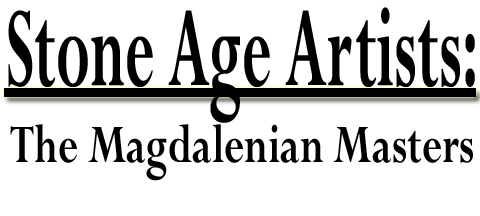 |
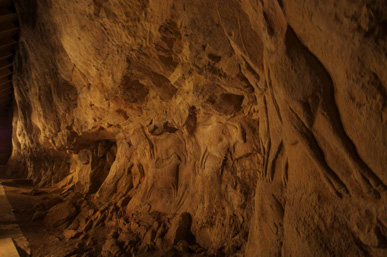
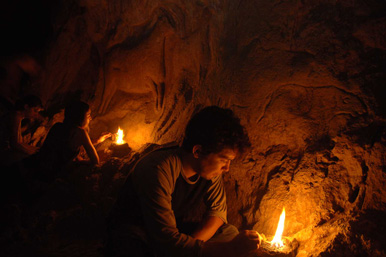
The inception of art in prehistoric times is a much debated issue. Some believe it coincides with a revolution of the mind, which is thought to have started about 40,000 years ago. Others think it is the result of gradual evolution that began with the very first human beings, some two million years ago. Our forefathers gradually devoted more and more time to art, decorating their objects and their places of residence. As for the Magdalenians, ancestors that settled in large areas of Europe between 18,000 and 10,000 years B.C., art was amazingly developed. The sculpted bas-relief of the Roc-aux-Sorciers site in southwestern France is proof that a golden age of prehistory did actually exist. For the first time ever, this film reveals the Lascaux cave, a showcase that suggests that the Stone Age may well have had its share of “Michelangelos.”
VIEW SHORT VIDEO CLIP:
Play with Windows Media Player: 300k or 700k
Length: 52 min.
Country: France
Language: English
Director: Philippe Plailly
Producer: Thierry Berrod, Mona Lisa Production
Producer Web site: http://www.monalisa-prod.com/
Distributor: Mona Lisa Production
Distributor Web site: http://www.monalisa-prod.com/
Festival Screenings and Awards:
Kineon: International Festival of Archaeological Film, Brussels, Belgium, 2009
Parscience 2009
International Archaeological Film Festival of the Bidasoa, Spain, 2009

